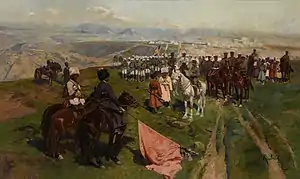| Battle of Qbaada | |||||||
|---|---|---|---|---|---|---|---|
| Part of Russo-Circassian War | |||||||
 Franz Roubaud. Reading the manifesto on the end of the Caucasian War by Grand Duke Mikhail Nikolaevich | |||||||
| |||||||
| Belligerents | |||||||
|
|
| ||||||
| Commanders and leaders | |||||||
|
| Tribal leaders | ||||||
| Units involved | |||||||
|
|
| ||||||
| Strength | |||||||
| 100,000-250,000 | 20,000 | ||||||
| Casualties and losses | |||||||
| Unknown but heavy | 20,000 | ||||||
| During the Circassian Genocide, about 1,500,000[1][2][3][4] indigenous highland Caucasians were expelled mainly to the Ottoman Empire, and a much smaller number to Persia. An unknown number of those expelled died during deportation.[5] | |||||||
The Battle of Qbaada (Adyghe: Ӏаткъуадж зауэ, romanized: 'atqwadj zawə; Abkhaz: Гәбаадәы аибашьра, romanized: Gubaadu aibashra; Russian: Кра́снополя́нская битва) was a battle in 1864 fought between the last remains of the Circassians and the Russian imperial forces during the Russo-Circassian War.[6][2][7][8][3][9][4][10] It is widely accepted as the last battle of the war as no other significant battles, other than scattered rebellions, occurred thereafter.[11][12][13][4][14]
History
The battle took place in Qbaada in 1864 between the Circassian army of 20,000 men and women, consisting of local villagers and militia as well as tribal horsemen, and a Russian army of 100,000 men, consisting of Cossack and Russian horsemen, infantry, and artillery. The Russian forces advanced from four sides. Circassian forces tried to break the line, but many were hit by Russian artillery and infantry before they managed to reach the front. The remaining fighters were soon defeated. The Russian army began celebrating victory on the corpses, and a military-religious parade was held, as 100 Circassian warriors were publicly executed.[15] The Russian army then continued raiding and burning Circassian villages, destroying fields to prevent return, cutting down trees, and driving the people to the Black Sea coast.[14]
References
- ↑ Richmond, Walter (2013). The Circassian Genocide. Rutgers University Press. back cover. ISBN 978-0-8135-6069-4.
- 1 2 "Çerkes Soykırımı nedir? 21 Mayıs 1864 Çerkes Sürgünü tarihçesi". Milliyet (in Turkish). Archived from the original on 2019-07-20. Retrieved 2021-01-13.
- 1 2 Неизвестные войны России. Взятие Кбааде и завершение Кавказской войны в 1864 г.
- 1 2 3 Ufuk Tavkul, "Kazaklar", Birleşik Kafkasya dergisi, Ankara, 2007, Sayı 6-7, sf. 33
- ↑ McCarthy 1995:53, fn. 45
- ↑ Semen Esadze. Çerkesya'nın Ruslar Tarafından İşgali. Ankara, 1995, sf. 123-132.
- ↑ Jineps,2006,ek-1,s.2
- ↑ T.V.Polovinkina, Çerkesya Gönül Yaram. Ankara, 2007, sf. 258
- ↑ Nıbe Anzor, 'Çerkes Meclisi 150 Yaşında', (In Turkish)
- ↑ "Çerkesler olimpiyat meşalesini söndürdü". www.cumhuriyet.com.tr (in Turkish). Retrieved 2021-01-13.
- ↑ Semen Esadze. Çerkesya'nın Ruslar Tarafından İşgali. Ankara, 1995, sf. 123-132.
- ↑ Jineps,2006,ek-1,s.2
- ↑ T.V.Polovinkina, Çerkesya Gönül Yaram. Ankara, 2007, sf. 258
- 1 2 Weismann, Ein Blick auf die Circassianer
- ↑ Kafkasya Bülteni, 19 Mayıs 1864